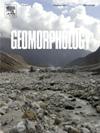Surface karst geomorphology in the Jahani salt extrusion, Zagros Mountains, Iran
IF 3.1
2区 地球科学
Q2 GEOGRAPHY, PHYSICAL
引用次数: 0
Abstract
This work analyses the superlative salt karst developed on Jahani salt extrusion (ca. 70 km2, 900 m in local relief). This active diapir is expressed as a salt fountain comprising a summit dome above the feeding vent and laterally spreading salt glaciers (i.e., namakiers) moving at rates of the order of cm/yr. The salt extrusion hosts the first documented and mapped salt karst poljes, developed at the foot of the steep rock salt slopes of the summit dome by differential suballuvial dissolution and expansion by rim dissolution. A cartographic inventory of 6489 sinkholes has allowed to characterise morphometrically the differences between the juvenile and mature sinkhole landscapes developed in the proximal and distal sectors of a namakier, respectively. Sinkholes developed in the recently expelled salt at the proximal sector have an average length four times smaller (23 m versus 83 m) and a density three times higher (600 versus 200 sinkholes/km2), reflecting the variable impact of expansion and coalescence processes. The Firuzabad River has trimmed the northern namakier, generating a 6 km long and > 400 m high salt escarpment, likely the largest on Earth. The dynamics of the escarpment is governed by the antagonistic roles of salt flow and rapid erosion by fluvial undermining, rock falls and dissolutional removal of the rock salt debris, causing severe hydrochemical degradation of the river waters. Exceptional halite rimstones occur in a marginal stream largely fed by permanent brine springs.
伊朗扎格罗斯山贾哈尼盐挤压地表岩溶地貌
本文分析了在贾哈尼盐挤压上发育的最高盐岩溶(约70 km2, 900 m)。这个活跃的底辟岩表现为一个盐喷泉,包括一个顶部的圆顶,在进料口和以厘米/年的速度移动的横向扩展的盐冰川(即namakiers)。盐挤压孕育了第一个有文献记载和绘制的盐岩溶poljes,这些poljes是在峰顶圆顶陡峭的岩盐斜坡脚下由不同的冲积次溶蚀和边缘溶蚀扩张形成的。对6489个天坑进行了地图学调查,从形态计量学上分别描述了namakier近端和远端发育的幼年和成熟天坑景观之间的差异。最近在近端区域排出的盐中形成的陷坑平均长度是原来的四倍(23米对83米),密度是原来的三倍(600对200个陷坑/平方公里),反映了膨胀和合并过程的不同影响。菲鲁扎巴德河修剪了北部的纳马克尔,形成了一条6公里长的河流。400米高的盐崖,可能是地球上最大的。断崖的动力学是由盐流和河流破坏、岩崩和岩盐碎屑溶解去除的快速侵蚀的对抗作用所控制的,造成了河水的严重水化学退化。特殊的盐岩边缘石出现在主要由永久盐水泉补给的边缘溪流中。
本文章由计算机程序翻译,如有差异,请以英文原文为准。
求助全文
约1分钟内获得全文
求助全文
来源期刊

Geomorphology
地学-地球科学综合
CiteScore
8.00
自引率
10.30%
发文量
309
审稿时长
3.4 months
期刊介绍:
Our journal''s scope includes geomorphic themes of: tectonics and regional structure; glacial processes and landforms; fluvial sequences, Quaternary environmental change and dating; fluvial processes and landforms; mass movement, slopes and periglacial processes; hillslopes and soil erosion; weathering, karst and soils; aeolian processes and landforms, coastal dunes and arid environments; coastal and marine processes, estuaries and lakes; modelling, theoretical and quantitative geomorphology; DEM, GIS and remote sensing methods and applications; hazards, applied and planetary geomorphology; and volcanics.
 求助内容:
求助内容: 应助结果提醒方式:
应助结果提醒方式:


